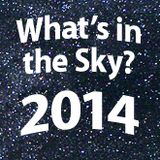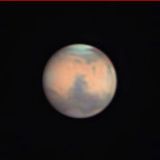
It's Saturn season! Right now is the best time of year to visit with the enigmatic planet Saturn and talk about what makes it so special. Whenever you are ready, let's find a relatively dark sky site and head out!
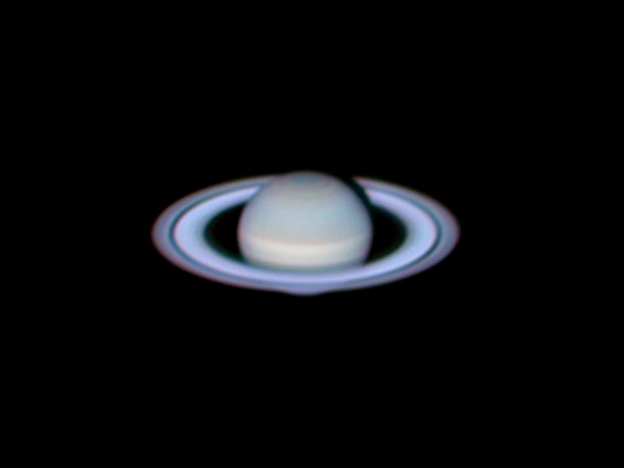
Saturn, by Cherdphong Visarathanonth in Bangkok, Thailand. Taken using an Orion SkyQuest XT8g Computerized GoTo Dobsonian Telescope.
During the 2014 Saturn season, the famous planet can be found in the constellation of Libra. However, this particular constellation isn't exactly easy to identify. For those new to astronomy, the best way to find Saturn is to locate the bright red star Antares, and brilliant blue-white star Spica. You'll find Saturn almost halfway between this conspicuous pair. If you allow your eyes plenty of time to adapt to the dark, you'll notice Saturn is creamy yellow and doesn't twinkle like its stellar counterparts. There is good reason for that. Planets are not only far closer than the stars, but the light you see from them is reflected; not generated.
Once you have located Saturn with just your eyes, stop and think about some very cool Saturn facts: Saturn is the second largest planet in our solar system and it was recorded as far back as 700 B.C. by the Assyrians, a group of people who once lived near modern-day Iraq. They called it the Star of Ninib, but the name Saturn comes from the Roman god of farming. This year, Saturn's rings are on full display, tilted towards our line of sight by about 22 degrees, and well on their way to a maximum tilt of 27 degrees in 2016.
Saturn will be at opposition on May 10. During opposition, the planet will rise directly opposite the Sun in the sky. However, there is more to this special date, because Saturn will also be the closest to Earth. Just how close is close? Let's try far. If you were to travel to Saturn by car at a speed of 70 mph and took no breaks, it would take 1,595 years to get there when Saturn is at its farthest point away from us. That's a mighty long time to go without stopping at for a snack or using the restroom!
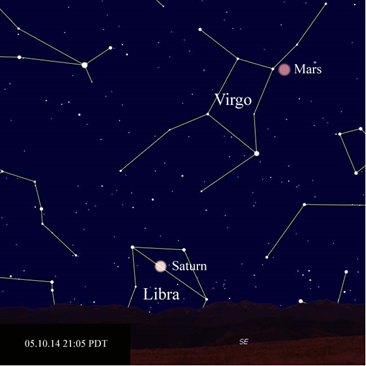
Saturn's position in the sky on the night of opposition.
Now, let's take a look at Saturn through binoculars and talk about it. If you can hold your binoculars very steady, you'll see an orb that is slightly stretched. This is very much like what Galileo Galilei saw in 1610. He thought the rings looked like "ears" and were "handles" or moons. In a secret anagram to his scientist friend, Johannes Kepler, Galileo wrote he had discovered that the "highest planet" was "triple-bodied."
Now we know what he was seeing was Saturn's famous ring system. While the planet itself is mainly composed of helium gas, the rings are made up of dust, ice and chunks of rock. These might be as small as a grain of sand, or as large as a house! The ring system is large, stretching across a distance which measures about halfway between the Earth and Moon. Although it might be wide, it's not very deep, and astronomers estimate the rings to be just a few hundred feet thick.
Are you ready to look at Saturn through a small telescope now? Small refractors easily reveal the planet's rings. In telescopes as small as 4.5", you'll begin to see a great many more details, such as Saturn's flattened shape. Yes, the rings are not the only thing that's flattened: Saturn rotates incredibly fast at 6,200 mph, causing the planet to bulge at its equator and its poles to flatten. If Saturn is spinning that fast, it should mean shorter "days," right? You bet. A day on Earth is 24 hours and a day on Saturn is 10 hours and 39 minutes.
Keep looking through your small scope, because you'll also see that Saturn has visitors. When the seeing is good, you can easily spot Saturn's largest moon, Titan, well away from the planet body - about two planet widths. However, look closely at the edge of the ring system over the nights and you stand a very good chance at spotting at least four more moons - Tethys, Rhea, Dione and Enceladus. They appear at different orbital positions at different times. Using computer software like "Starry Nights" can help you determine which ones you may have observed. Saturn's moon Titan is the second-largest moon in the solar system, and it is the only known moon to have a substantial atmosphere, which is 370 miles deep, 10 times thicker than Earth's atmosphere. While it might be quiet to look at, Titan is a really noisy place. Its winds sound much louder because its dense atmosphere intensifies sound waves.
Did someone say windy? Yep. It's windy on Saturn, too. Winds in Saturn's atmosphere travel up to 1,100 mph. That's almost four times faster than the strongest tornadoes on Earth!
As your telescope size increases, so does the resolution. This means you'll start to see differences in the planet's body coloration, which indicate storms. Sometimes, Saturn can have some very wild storms that can last for weeks, or even years! In 2004, a storm on Saturn named the "Dragon Storm," created mega-lightning 1,000 times more powerful than lightning on Earth. According to a national press release, in early 2010, amateur astronomers spotted a massive ammonia blizzard raging on Saturn. The monster storm is five times larger than "Snowmageddon," the snowstorm that shut down Washington D.C. in February 2010. Just think - that means observers like you and me can often spot things that professional observatories might miss!
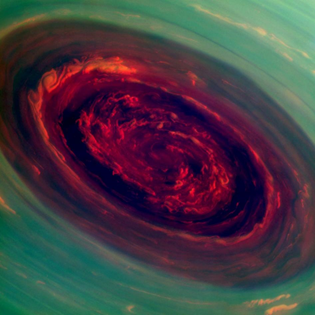
False-color image of the spinning vortex of Saturn's north polar storm, from NASA's Cassini spacecraft.
Are you ready to observe Saturn with a large telescope now? Then let's talk about what you might see. When conditions are steady and you're able to use a lot of magnification, you can see many divisions in the ring system. They'll look very similar to an old-fashioned record album. Saturn has seven main rings that consist of thousands of smaller rings. The ring farthest from the planet, the E ring, is about 180,000 miles across. In contrast, the F ring is about 20-300 miles wide. One of the easiest to see (even with small scopes) is known as the Cassini Division. It was discovered in 1675 by Giovanni Cassini at the Paris Observatory using a telescope of only 2.5" aperture. Although a whole book can be written about observing Saturn's ring system with a large telescope, there are two very unique things to look for. The first is fairly easy: spying the body of Saturn through the Cassini Division. The second is transient and far more difficult. It is called "spoking. " It is a rare occurrence, but not an impossible one. It looks like bolts of lightning captured in the ring plane - like spokes on a wheel. It has been this author's great privilege to have seen spoking in person using a 32" telescope, so it is a reality.
All in all, 2014 should be an interesting year to observe Saturn. On the 14th of May, just four nights after opposition, Saturn and the Moon will be less than a degree apart. If you're clouded out, try looking again on July 8th when the pair is about a degree and a half apart. If you're interested in unusual pairings, try observing on the nights of September 11-13th when it cruises the ecliptic plane accompanied by asteroid Vesta about 1 to 2 degrees away. And if you're looking for a fun sight to point out to family and friends, check out Saturn on the night of August 31st, when the yellow giant will be triangulating with Mars and the Moon a scant four degrees apart. Now, that's a Kodak moment!
Tips for the Best Views:
When it comes to viewing Saturn, viewing conditions are a key requirement. No matter what size optical equipment you use, the steadiness of the sky plays a major role in the amount of details you can see. Looking at Saturn in an unstable sky would almost be like looking at it under running water - and using high magnification during bad seeing only magnifies the bad seeing. Using a yellow filter can assist in revealing some details, but isn't necessary to have a good viewing session. It never hurts to try a variety of filters, but remember they dim the image, especially with a smaller scope.
Try using my three "Ps" of amateur astronomy: Patience, Practice and Persistence. Have patience when you are viewing Saturn. Bad skies can sometimes only be bad moments, and by patiently viewing for an extended period of time, you will be rewarded with the one moment that takes your breath away with its clarity. Practice is mandatory. You'll never see intricate details unless you practice seeing them. Try your hand at sketching while at the eyepiece. This practice allows you to open your mind to what you can see by focusing your attention on smaller areas. Last of all is persistence. Keep at it. If you don't see something on one night - you just might see it on another. And discover why Saturn is the real "Lord of the Rings"! Thanks to Mike Romine for the inspiration!
What did you think of Saturn the first time you saw it through a telescope? Leave a Review on this article, and share your experience.
About Tammy Plotner - Tammy is a professional astronomy author, President Emeritus of Warren Rupp Observatory and retired Astronomical League Executive Secretary. She's received a vast number of astronomy achievement and observing awards, including the Great Lakes Astronomy Achievement Award, RG Wright Service Award and the first woman astronomer to achieve Comet Hunter's Gold Status.




